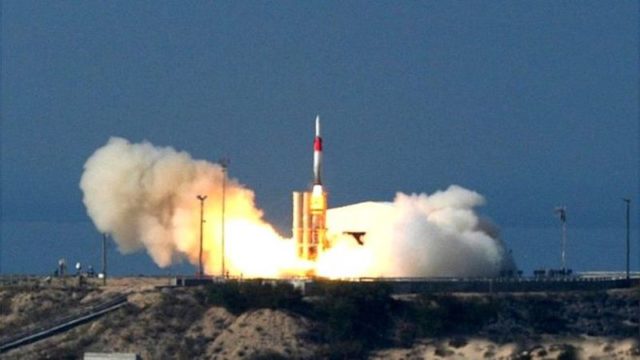Israel has shot down a Syrian missile heading for Israeli territory using its advanced Arrow anti-ballistic missile system. The remains of the Syrian missile, and some parts of the Arrow rocket, crashed in and around the northern Jordanian village of Anbata in Irbid province. Depending on the trajectory of the intercepted Syrian missile, reports say it was programmed to hit in the Jerusalem area. According to the Jordanians, it was aimed “toward Israeli positions and bases.”
The use of the Arrow against an allegedly surface to air missile raises many questions, most of them, so far, lacking answers.
There are two general theories: the first theory is that the Arrow acquisition radars and computers considered the Syrian air to air missile a threat and knocked it out.
The second theory is that the Arrow took out a much larger missile, a surface to surface type, probably a SCUD or SCUD variant. SCUDs are deployed by the Syrian Army and SCUDs and SCUD variants (some made in North Korea, others locally in Iran) are in the hands of the Iranians. Whether any Iranian-controlled SCUDs are in Syria is an interesting question.
The theories can be combined: it is known that three missiles were fired. Two of them, according to news reports, landed harmlessly on Israeli territory. It is known that none of the missiles were fired while Israeli jets were on their bombing run in northern Syria, ostensibly against Hezbollah-related targets. The missiles were fired when the Israeli jets were already returning home inside Israeli territory, a rather late response to the attack.
Israel’s modern air defense systems, including Iron dome, rely on the Green Pine radar system which projects where the missiles are heading and only goes after those that the system perceives as a threat to sensitive targets or population centers. This probably means that only one missile launch was identified as a threat and it was destroyed.
Some interesting questions arise from the nature of the event. Israel is very careful to coordinate its operations with the Russians in a process popularly known as “deconfliction.” The U.S. does the same with the Russians, but less assiduously. One presumes, therefore that the Israelis let the Russians know they were carrying out an operation, but this time farther north in Syria than typically. Did the Russians alert the Syrian Air Force and Syrian Air Defense system s? Did the Iranians know about the impending Israeli attack? Alternatively, after the Syrians belatedly fired a couple of surface to air missiles, did the Iranians launch a surface to surface missile that lit up the Arrow defenses?
Iran has even more SCUD-type missiles than Syria, including locally produced versions based on the North Korean Rodong I (sometimes Nodong 1) missile known as the Shahab 3. These missiles have a range of more than 1,000 KM and can carry a large warhead of around 2,000 pounds. Had such a warhead hit Jerusalem or other populated target in Israel, it would have touched off a general war involving Israel, Syria and Iran. What Russia would or could do under these circumstances no one actually knows, but the Russians for sure do not want to see Israel take out their Syrian and Iranian comrades.
One tipoff as to whether this hypothesis is correct may manifest itself in Russia’s behavior over the next few days, especially regarding Iran. Iran can get Russia into a wider war it will lose, and Russia’s leaders know that, which is why they are always walking a tightrope when it comes to accommodating Israel.
There remains the possibility that the Arrow shot down a surface to air system, but one that appeared to its computers to be on a path where it could have caused real harm. It is presumed the missile was the Russian-made S-200 (known by NATO as the SA-5). Some versions of the SA-5 can carry a large warhead, and the ones in Russia but not exported can even carry a small nuclear warhead. Could the Iranians have modified the SA-5’s (also in their inventory, as in Syria’s) to carry a nuclear warhead, and these firings were a test? Such a weapon would be used to neutralize a conventional attack by aircraft and missiles by Israel against Iran, though it is very speculative (bordering on the non-credible) that the Russians would allow Iran such experimentation at their own peril.
Until some of these matters are better clarified, it is hard to know what the truth really is. But it is not hard to recognize that the risks have greatly escalated with the decision to use the Arrow system to defend against a potentially great threat.


